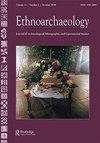Bridging Ethnoarchaeology and Archaeology in the Ethiopian Gamo Highlands
IF 1.3
0 ARCHAEOLOGY
引用次数: 0
Abstract
ABSTRACTThis article is a case study that applies long-term ceramic ethnoarchaeology to recent archaeological research in the Gamo region of Ethiopia. The region is located on the western escarpment of the Great Rift Valley. Today, an important cultural characteristic of the Gamo is their caste system. They divide society into occupational castes including Mala farmers and Tsoma artisans who are segregated in their access to land and food resources. Working collaboratively with Gamo Boreda elders, we located a historic Mala household at the archaeological site of Ochollo Mulato (1270–1950 CE) and an artisan household at the archaeological site of Garu (eighteenth and nineteenth centuries CE). The historic archaeological pottery assemblages from Ochollo Mulato and Garu are considered in light of thirty years of Gamo ceramic ethnoarchaeological research to understand changes in subsistence and social organization through time.KEYWORDS: GamoEthiopiacastepotteryceramicsfeastingbeerculinary AcknowledgmentsI would like to first thank the Gamo people for accepting me into their communities and homes, and for being gracious hosts and teachers. Each time I am fortunate to be in Gamo, they teach me new expressions of thought, and for this I am grateful. This article is dedicated to Jim Skibo, friend, and mentor. I thank Brenda Bowser for inviting Tania Valamoti and me to contribute a Special Issue in the journal Ethnoarchaeology as an outcome of the WAC-9 session Breaking Bread and Raising a Glass: Bridging Ethnoarchaeological and Archaeological Research on Food and Culinary Habits. My field research experience is always enhanced because I am lucky to have Kathryn Weedman Arthur and Matthew C. Curtis as colleagues and friends. I thank Kathryn Arthur for creating Figure 2 and Matthew C. Curtis for producing Figure 8 and Figure 10. I thank the reviewers who took the time to review the manuscript. Permission for this research was given by the Authority for Research and Conservation of Cultural Heritage, which is part of Ethiopia’s Ministry of Culture. Each day Kathy and Hannah Arthur confirm to me that love is more than a dream.Disclosure StatementNo potential conflict of interest was reported by the author(s).Additional informationFundingThis work was supported by the National Science Foundation [Grant Number BCS-1027607], the National Endowment for the Humanities, and the University of South Florida St. Petersburg and Tampa.Notes on contributorsJohn W. ArthurJohn W. Arthur is Professor of Anthropology at the University of South Florida. He has worked in Ethiopia since 1995 conducting ceramic ethnoarchaeological and Holocene archaeological research. He has received funding from the National Science Foundation and the National Endowment for the Humanities and has published two books as well as numerous articles in journals such as Science, Nature, and PNAS. While working in Ethiopia, Dr. Arthur began to research the importance of beer in contemporary people’s lives, which led to his most recent book, Beer – A Global Journey through the Past and Present, published by Oxford University Press.衔接埃塞俄比亚加莫高地的民族考古学和考古学
摘要本文是将长期陶瓷民族考古学应用于埃塞俄比亚加莫地区近期考古研究的一个案例研究。该地区位于东非大裂谷的西部悬崖上。今天,加莫人的一个重要文化特征是他们的种姓制度。他们将社会划分为职业种姓,包括马拉农民和托马工匠,他们在获得土地和粮食资源方面被隔离。与Gamo Boreda长老合作,我们在Ochollo Mulato考古遗址(公元1270-1950年)找到了一个历史悠久的Mala家庭,在Garu考古遗址(公元18 - 19世纪)找到了一个工匠家庭。从奥乔洛穆拉托和加鲁的历史考古陶器组合来看,根据三十年的加莫陶瓷民族考古研究,了解生存和社会组织的变化。我首先要感谢加莫人接受我进入他们的社区和家园,感谢他们的盛情款待和老师。每次我都很幸运地来到加莫,他们教会了我新的思想表达方式,对此我很感激。这篇文章献给吉姆·斯基博,他是我的朋友和导师。我感谢布伦达·鲍泽邀请塔尼亚·瓦拉莫蒂和我为《民族考古学》杂志撰写一期特刊,作为WAC-9会议“掰面包和举杯:连接民族考古学和食物和烹饪习惯的考古研究”的成果。我的实地研究经验总是得到加强,因为我很幸运有凯瑟琳·魏德曼·亚瑟和马修·c·柯蒂斯作为同事和朋友。我感谢Kathryn Arthur创造了图2,感谢Matthew C. Curtis创造了图8和图10。我感谢花时间审稿的审稿人。这项研究是由埃塞俄比亚文化部下属的文化遗产研究和保护管理局批准的。每一天,凯西和汉娜·阿瑟都向我证实,爱不仅仅是一场梦。披露声明作者未报告潜在的利益冲突。本研究得到了美国国家科学基金会(授权号:BCS-1027607)、美国国家人文基金会、南佛罗里达大学圣彼得堡分校和坦帕分校的支持。作者简介:john W. Arthur,南佛罗里达大学人类学教授。自1995年以来,他一直在埃塞俄比亚从事陶瓷民族考古和全新世考古研究。他获得了美国国家科学基金会和美国国家人文基金会的资助,并出版了两本书,在《科学》、《自然》和《美国国家科学院院刊》等期刊上发表了大量文章。在埃塞俄比亚工作期间,亚瑟博士开始研究啤酒在当代人生活中的重要性,这导致了他最近的一本书,啤酒-穿越过去和现在的全球之旅,由牛津大学出版社出版。
本文章由计算机程序翻译,如有差异,请以英文原文为准。
求助全文
约1分钟内获得全文
求助全文
来源期刊

Ethnoarchaeology
ARCHAEOLOGY-
CiteScore
1.60
自引率
0.00%
发文量
10
期刊介绍:
Ethnoarchaeology, a cross-cultural peer-reviewed journal, focuses on the present position, impact of, and future prospects of ethnoarchaeological and experimental studies approaches to anthropological research. The primary goal of this journal is to provide practitioners with an intellectual platform to showcase and appraise current research and theoretical and methodological directions for the 21st century. Although there has been an exponential increase in ethnoarchaeological and experimental research in the past thirty years, there is little that unifies or defines our subdiscipline. Ethnoarchaeology addresses this need, exploring what distinguishes ethnoarchaeological and experimental approaches, what methods connect practitioners, and what unique suite of research attributes we contribute to the better understanding of the human condition. In addition to research articles, the journal publishes book and other media reviews, periodic theme issues, and position statements by noted scholars.
 求助内容:
求助内容: 应助结果提醒方式:
应助结果提醒方式:


